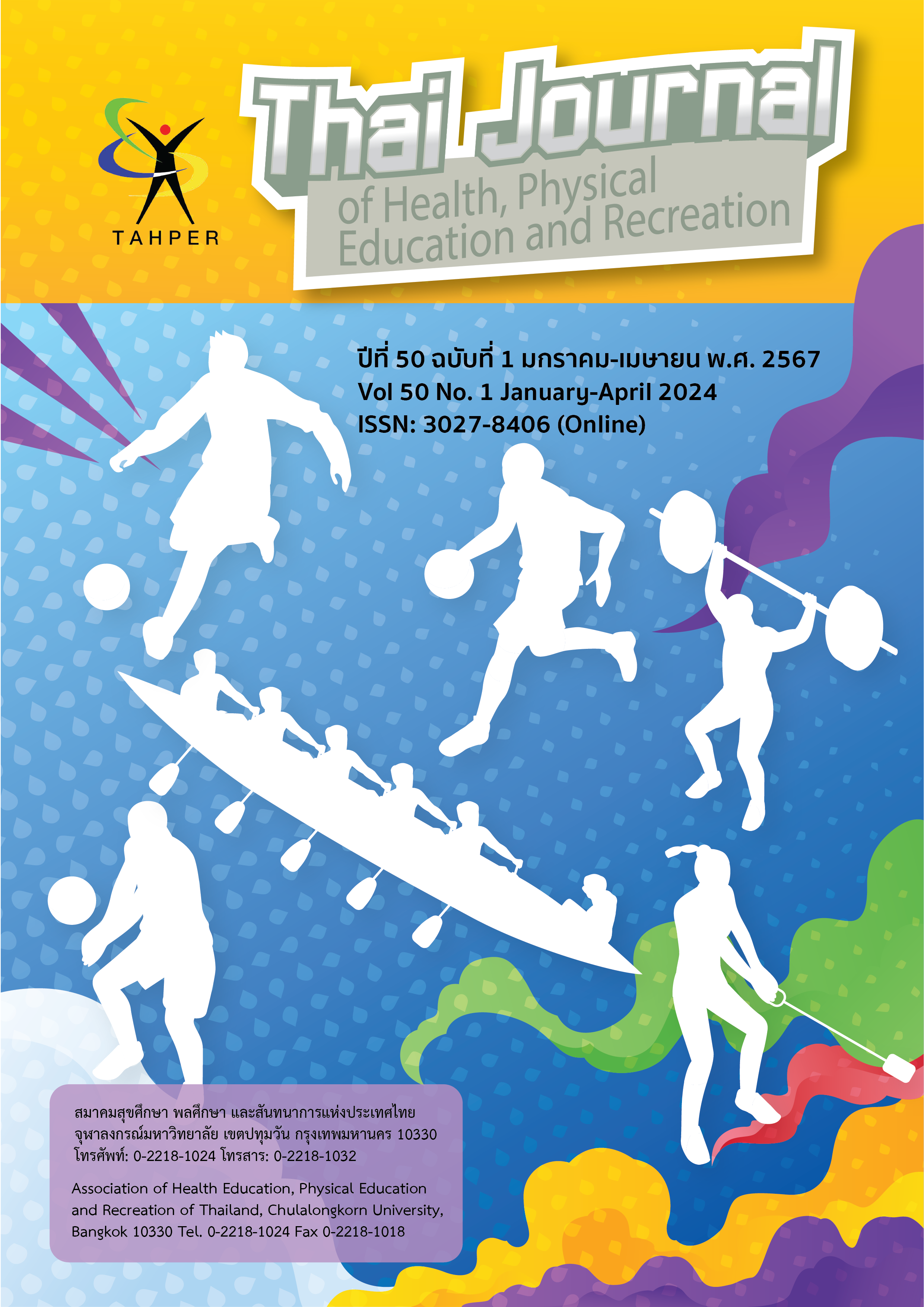Analysis of Intensity of Wheelchair Tennis Man Match - Played
Main Article Content
Abstract
The purpose of this study was to compare intensity during simulated wheelchair tennis matches played between winners and losers. 8 male wheelchair tennis athletes from Thailand Team were participated in this study. Installed a Polar H10 wireless heart rate monitor and recorded the data using Polar Team software. The researcher simulated best of 3 match to measure the heart rate during the competition. Data were analyzed, using mean, standard deviation. The differences were compared using Independent T-Test at the 0.05 level of significance.
The result showed that HRMax of winner group and loser group during the competition were no different at 0.05 level of significance. And heart rate at variables of intensity of winner group and loser group were 61% - 70% HRmax. difference was statistically significant at the 0.05 level.
The result of this study will be helpful in developing a specific training program for wheelchair
tennis players.
Article Details

This work is licensed under a Creative Commons Attribution-NonCommercial-NoDerivatives 4.0 International License.
Critical thinking in journals is the right of the author. The Association of Health Education, Physical Education and Recreation of Thailand is not always required, to create diversity in ideas and creativity.
ความคิด ข้อวิพากษ์ในวารสารเป้นสิทธิของผู้เขียน สมาคมสุขศึกษา พลศึกษา และสันทนาการแห่งประเทศไทยไม่จำเป็นต้องเห็นชอบด้วยเสมอไป เพื่อให้เกิดความหลากหลายในความคิดและความสร้างสรรค์
References
ณัฐวุฒิ มณีใส นิรอมลี มะกาเจ เพ็ญนิภา พูลสวัสดิ์ และศุภวรรณ วงศ์สร้างทรัพย์. (2563). การวิเคราะห์ระดับความหนักของเกมการแข่งขันกีฬาคอร์ฟบอล. การประชุมวิชาการระดับชาติ มหาวิทยาลัยเกษตรศาสตร์ วิทยาเขตกำแพงแสน ครั้งที่ 17 วันที่ 2 – 3 ธันวาคม 2563. หน้า 4681 - 4691.
Bayles, M. P. (2023). ACSM’s exercise testing and prescription : Lippincott Williams & Wilkins.
Blomqvist, M., Luhtanen, P., & Laakso, L. (2000). Expert-novice differences in game performance and game understanding of youth badminton players. European Journal of Physical Education, 5(2), 208-219.
Diaper, N. J., & Goosey-Tolfrey, V. L. (2009). A physiological case study of a paralympic wheelchair tennis player: reflective practise. Journal of sports science & medicine, 8(2), 300.
Friedl, K. E., DeWinne, C. M., & Taylor, R. L. (1987). The use of the Durnin-Womersley generalized equations for body fat estimation and their impact on the Army Weight Control Program. Military Medicine, 152(3), 150-155.
Gibson, A. L., Wagner, D., & Heyward, V. (2019). Advanced fitness assessment and exercise prescription, 8E: Human kinetics.
Goosey-Tolfrey, V. L., & Leicht, C. A. (2013). Field-based physiological testing of wheelchair athletes. Sports medicine, 43, 77-91.
Makaje, N., Ruangthai, R., Arkarapanthu, A., & Yoopat, P. (2012). Physiological demands and activity profiles during futsal match play according to competitive level. Journal of Sports Medicine and Physical Fitness, 52(4), 366.
Maneesai., N., Makaje., N., Ruangthai., R., & Phunsawa., P. (2021). Playing Pattern Analysis of Single Badminton Matches in Professional Players. Journal of Health, Physical Education and Recreation, 47(2), 86-100.
Póvoas, S. C., Seabra, A. F., Ascensão, A. A., Magalhães, J., Soares, J. M., & Rebelo, A. N. (2012). Physical and physiological demands of elite team handball. The Journal of Strength & Conditioning Research, 26(12), 3365-3375.
Sánchez-Pay, A., & Sanz-Rivas, D. (2020). Wheelchair tennis, from health to competitive analysis: A narrative review.


